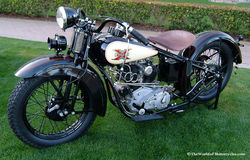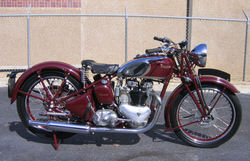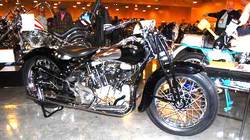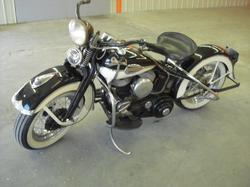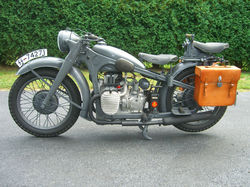The Motorcycle from the 1920's to the 1940's:
The Motorcycle Matures and Becomes An Established Form Of Transportation:
Between World War I and World War II, the motorcycle came into it's own. It was no longer an "experiment" but had found it's place as a serious form of transportation. Engineering had also made the motorcycle a modern form of transportation. The motorcycle was used extensively in WWI and again in WWII. The military used the best of the best and furthered the reliability of the motorcycle. During WWI, the motorcycle was tested against the horse but in WWII, the horse was no longer an option.
The stock market crash of 1929 causes numerous companies to go bankrupt but the strong companies survived. Indian was never the same while Harley hangs on and becomes the dominant American manufacturer. In England, Triumph and BSA become the two most significant companies on their side of the Atlantic. Motorcycling remains stronger and more diverse overseas than in the US.
The 1925 Excelsior X!
The 1938 Triumph Speed Twin!
Edward Turners Triumph "Speed Twin" was the most advanced motorcycle of the day and was the framework for nearly all British motorcycles for the next 40 years. The Brit bikes were much lighter, handled well, and had classic and refined looks.
The BMW motorcycle is a branch of the larger company which built automobiles, farm equipment and other industrial products. The initial designer, Max Fritz, designed a flat twin which was to become the mainstay for BMW motorcycles till the 1980's. BMW had unit construction crankcases, drive shafts, and earls forks from the beginning. German motorcycles were often advanced designes and well built machines. After WWII, the Japanese copied numerous German designes such as Horex and Adler.
Traits of the mortorcycles during the period from WWI and WWII:
1. By the end of the 1920's, motorcycles grew in power, reliability, and durability;
2. The US, England, Germany, and Italy had become the dominant builders of motorcycles;
3. In England, the single continued strong till Triumph's Speed Twin came along while the V-Twin dominated in the US;
4. By 1920, the motorcycle speed record was 103mph and by 1929 it had grown to 129mph, 1937 saw 169mph on a supercharged JAP engined motorcycle;
5. By the teens, 3speed transmissions were the standard and by the late 1930's the 4speed transmissions were very common;
6. After 1934, foot shifters become much more common. From 1939, rear swing arms begin to grow in popularity (beginning with the "plunger"design); From the late 1940's, teloscopic front forks are installed on more and more bikes;
7. US Motorcycles sales were in the 20 to 30,000 units range during the 1920's but during the 1930's those figures were nearly cut in half.
8. Bill Johnson, later to become a major importer of British bikes in the US, begins selling Triumph, BSA, and Arie. It's not untoil after WWII that the growth in dealerships grows;
9. As 3 wheelers were common in the first 10 years of the sport, now side cars were became more common;
